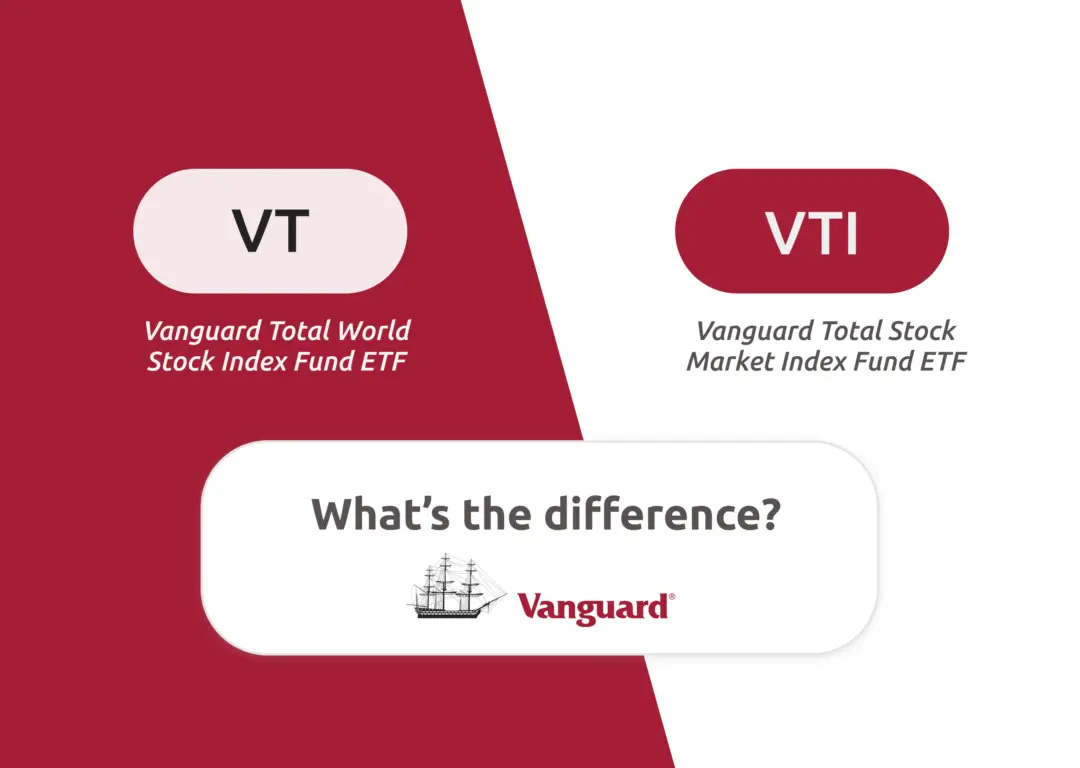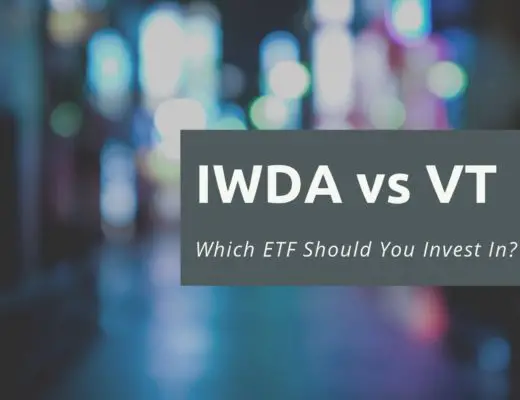Last updated on December 29th, 2021
You may be looking to invest in one of the Exchange Traded Funds (ETFs) that are managed by Vanguard. With a range to choose from, it may be difficult to pick one that suits your risk appetite. There are both the VT and VTI ETFs, and they sound really similar!
So how do they differ from each other?
Here, let’s take a closer look at these ETFs from one of the biggest U.S. registered investment advisors, Vanguard.
Contents
The Difference Between VT and VTI
While Vanguard Total World Stock Market (VT) and Vanguard Total US Stock Market (VTI) are passively managed by the Vanguard Group, both ETFs are fundamentally very different.
VT comprises global stocks and has more holdings (around 9,000) compared to VTI, which only contains US stocks (around 3,000). However, this comes at a price as the expense ratio of VT is more than twice that of VTI.
Let’s break down the differences for you, starting with the funds’ portfolio.
Fund Portfolio
VT tracks the FTSE Global All Cap Index. Or simply, the performance of more than 7,000 large, mid and small companies in developed and emerging markets worldwide.
As such, it aims to offer you exposure to a well-diversified portfolio of stocks.
VT also employs a sampling approach to track the index. The sampling approach refers to when a portion of holdings from the index is taken to derive its price.
For example, if only 90% of the assets from an index are included in an ETF’s holdings, the fund is using a sampling method.
This approach helps to optimise the exposure to the index.
VTI, on the other hand, tracks CRSP US Total Market Index. This represents publicly traded U.S. stocks in the market.
The index includes stocks from large, mid, small, and micro companies that are traded on the Nasdaq Stock Exchange. Similar to VT, the fund invests by sampling the index as explained above.
Portfolio Comparison
Here, let’s analyse these two ETFs’ portfolios.
Number of Holdings
As of 31 May 2021, VT has a total of 9,045 stocks. 13.7% of its net assets come from 10 of its largest holdings.
This includes some of the biggest multinational corporations worldwide, such as:
- Apple Inc.
- Taiwan Semiconductor Manufacturing Co. Ltd.
- Alphabet Inc.
- Tesla Inc.
The number of stocks in VTI, however, is much lower. This is so because it only takes into account the market performance of stocks from US companies.
As of 31 May 2021, VTI comprises a total of 3,791 stocks. 22.4% of its net assets are derived from 10 of its largest holdings.
Unlike VT, these holdings consist of only U.S. companies such as:
- Microsoft Corp.
- Tesla Inc.
- Apple Inc.
Due to the smaller number of holdings, VTI is more concentrated towards the top holdings. This is good when these top companies perform well, so your returns will be higher.
However, if these companies perform badly, your losses will be quite high too!
Though VT may have a larger number of total stocks, VTI has a higher number of assets under management (AUM) of $1.2 trillion. On the other hand, VT’s AUM sits at $30.4 billion.
Both funds have a large AUM. As such, both funds are rather reputable which you can consider to invest in either one.
Holding Comparison
With the two ETFs containing similar portfolios, there will be some stocks that are found in both funds. There is an overlap of around 1,700 holdings between these funds.
21.8% of VT’s holdings are included in VTI while 46.7% of VTI’s holdings are in VT.
This means that almost half of VTI’s stocks are included in VT!
The graph here shows some of the overlapping stocks included in both ETFs. It is important to note that the weight of these holdings – which are also known to be some of the biggest companies worldwide – in VTI are larger in comparison to VT.
Let’s take a look at the different types of companies in each ETF.
Here are the top 10 holdings to note between the two.
VT:
VTI:
Both ETFs present the exact same top 10 holdings of the most established companies in the market. These firms are known to be leaders within their own industries and provide you with some form of stability within their portfolios.
Sector Comparison
While VT comprises companies globally, the sector profile of both ETFs are similar. They constitute a vast range of industries to ensure diversification within the portfolios. Below, we break down the top five sectors for each ETF.
| Sector | VT | VTI |
|---|---|---|
| Technology | 25.48% | 30.97% |
| Financials | 17.73% | 14.97% |
| Consumer Cyclicals | 13.71% | 15.24% |
| Industrials | 11.39% | 10.27% |
| Healthcare | 10.93% | 13.15% |
As noted from the table above, VTI comprises a larger number of stocks in the Technology sector compared to VT. However, VT has a higher amount in these sectors than VTI:
- Financials
- Consumer Cyclicals
- Consumer Non-Cyclicals
- Industrials sectors
When it comes to choosing between the two based on the sector profiles, it really boils down to your preference for the stated industries above.
If you believe that a certain sector will do well, you may want to have a higher weightage towards that sector.
Market Capitalisation
VT has an added advantage as it consists of a diverse spread of global companies, each with varying market caps. Thus, its weighted average market capitalisation is $5.7 billion.
On the contrary, VTI invests in the largest U.S. companies in the Nasdaq Stock Exchange. Therefore, it has a larger weighted average market capitalisation of $96.1 billion.
Unit Price
A unit price refers to the price you would pay for an individual unit of an ETF. Since both VT and VTI are ETFs that are traded in the US, the minimum you can buy for each ETF is 1 unit.
The ability to compare both unit prices offer clarity as to which ETF is more affordable. This is especially critical if you have limited capital.
Here are the unit prices for each unit of VT and VTI at the time of writing:
| VT | VTI | |
|---|---|---|
| Unit Price | $103.59 | $223.69 |
Comparing their prices, VTI has a relatively higher unit price compared to VT. This means that for every two units of VT, you can only buy one unit of VTI. Thus, this makes VT a more feasible option if you have a small capital.
Fees and Taxes
Investing in ETFs would incur additional costs and this differs based on the ETF. These additional costs may significantly eat into your profits. As such, it is important that you are aware of these costs. Here, let’s break down two worth noting.
Withholding Tax
Since both VT and VTI are domiciled in the US, a non-resident of the country would be subjected to a 30% withholding tax on the dividends. This would mean that if you were a non-resident alien of the US looking to buy either of the ETFs, you would have to pay an additional 30% withholding tax on the dividends earned from the funds.
To obtain the withholding taxes, you can calculate the amount of withholding taxes paid relative to the ETF’s unit price. Thus, knowing the ETF’s dividend yield is required.
Here are the estimated withholding taxes for both VT and VTI as of June 2021.
| VT | VTU | |
|---|---|---|
| Dividend Yield | 0.82% | 0.69% |
| Estimated Withholding Tax | 0.25% | 0.21% |
| Dividend Yield (After Tax) | 0.57% | 0.48% |
As shown in the table, VTI has a lower withholding tax compared to VT. However, it is also important to take note of the dividend yield!
This allows you to calculate an estimated withholding tax that would ultimately affect the dividend yield you will receive. In this case, although VTI has a lower estimated withholding tax, it also has a lower dividend yield. Hence, the dividend yield you receive will be lower than that of VT.
Expense Ratio
Another additional cost that is critical to take into account is the expense ratio. Expense ratios are the costs that you would have to pay to the company (in this case: Vanguard) in return for their services.
Again, just as with any other additional costs, it is important to identify them before making an investment decision since large values of expense ratios may jeopardise your profits.
Below are the expense ratios for both VT and VTI.
| VT | VTI | |
|---|---|---|
| Expense Ratio | 0.08% | 0.03% |
Since both ETFs are passively managed, the expense ratios are relatively low (less than 0.1%).
However, the cost of investing in VT is more than twice that if you choose to invest in VTI. This could probably be due to the greater costs involved in managing a global stock fund compared to a fund that just contains US stocks.
Liquidity
Liquidity refers to how easy it is for you to convert an asset into cash. The easier it is for an asset to turn into cash, the more liquid it is.
Comparing the liquidity between these 2 ETFs allows you to understand the ability to buy or sell the units at your intended price. With a higher trading volume, it means that there is a higher demand for this ETF.
To understand the liquidity of an ETF, you can refer to the average trading volume. Here are the average trading volumes for both VT and VTI as of 2 July 2021.
| VT | VTI | |
|---|---|---|
| Average Trading Volume | 1.542 million | 3.142 million |
Both ETFs have quite high liquidity as their average trading volume is in the millions. You should not have any problems in buying or selling these ETFs at your intended price!
Verdict and Conclusion
Here’s a summary of what has been discussed when comparing between VT and VTI.
| VT | VTI | |
|---|---|---|
| Index Tracked | FTSE Global All Cap Index | CRSP US Total Market Index |
| Fund Manager | Vanguard | Vanguard |
| Currency | USD | USD |
| Number of Holdings | 9,045 | 3,791 |
| AUM | $30.4 billion | $1.2 trillion |
| Sector Comparison | Technology Financials Consumer Cyclicals Industrials Healthcare | Technology Financials Consumer Cyclicals Industrials Healthcare |
| Market Capitalisation | $5.7 billion | $96.1 billion |
| Unit Price | $103.59 | $223.69 |
| Estimated Withholding Tax | 0.25% | 0.21% |
| Expense Ratio | 0.08% | 0.03% |
| Average Trading Volume | 1.542 million | 3.142 million |
So, which ETF should you invest in?
The first step is to always consider your current investment portfolio. If your existing portfolio consists of stocks from non-US companies, you may want to consider parking a portion of your capital in VTI to offer additional exposure to the US market.
If you believe that the US economy will continue to perform well in the long run, then you can choose to invest in VTI too!
If you are looking for a more diversified option, VT may be a better choice since it offers exposure to a range of companies globally. This way, you are not concentrating all your risk into the US market and instead, are buying into the market as a whole.
However, it is always important to note before investing in any of the two ETFs to understand:
- The costs
- Sector profile
- All the key characteristics as stated in the table
When comparing the two, VT clearly incurs a higher cost as compared to VTI, and it is slightly less liquid too. These are important factors to consider to get an in-depth understanding and knowledge of what you are buying into. If such costs are not too much of a problem, then opting for VT would be a reasonable choice!
It is also possible for you to buy both ETFs together. However, one thing to take note of is the overlap in holdings that you’ll have when buying them both.
This means that your exposure to certain companies may be much higher!
Lastly, BlackRock has an ETF (IWDA) that is similar to either ETF, and you can find out how it differs from VT as well as VTI.

Do you like the content on this blog?
To receive the latest updates, you can follow us on our Telegram channels (Personal Finance or Crypto) and Facebook.
Are you passionate about personal finance and want to earn some flexible income?





